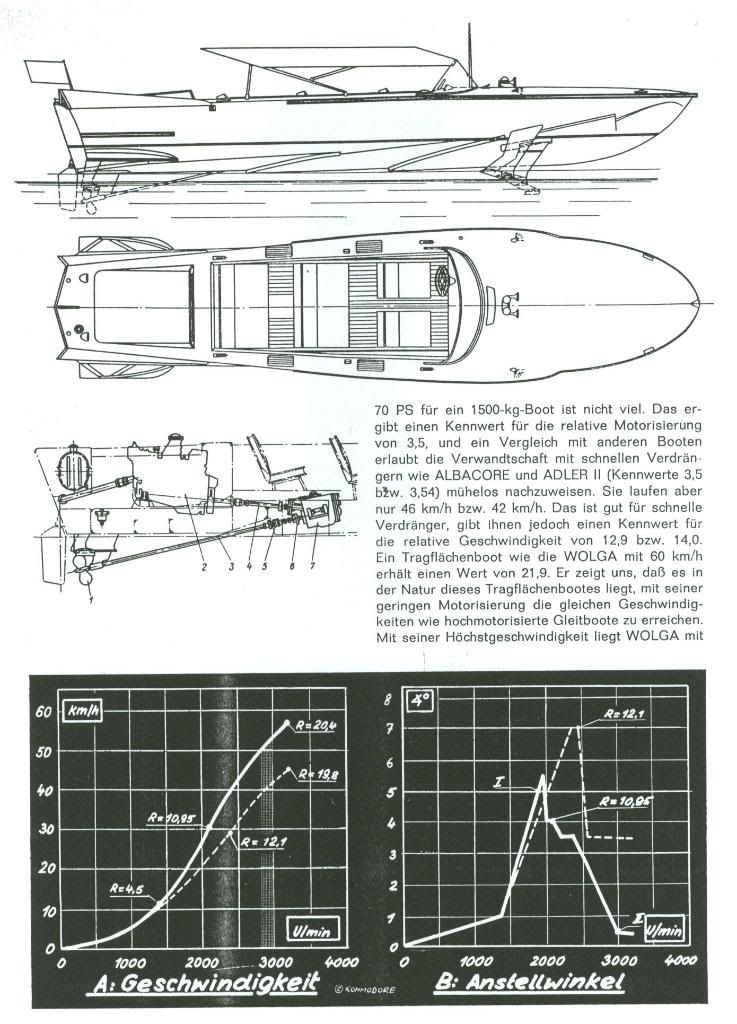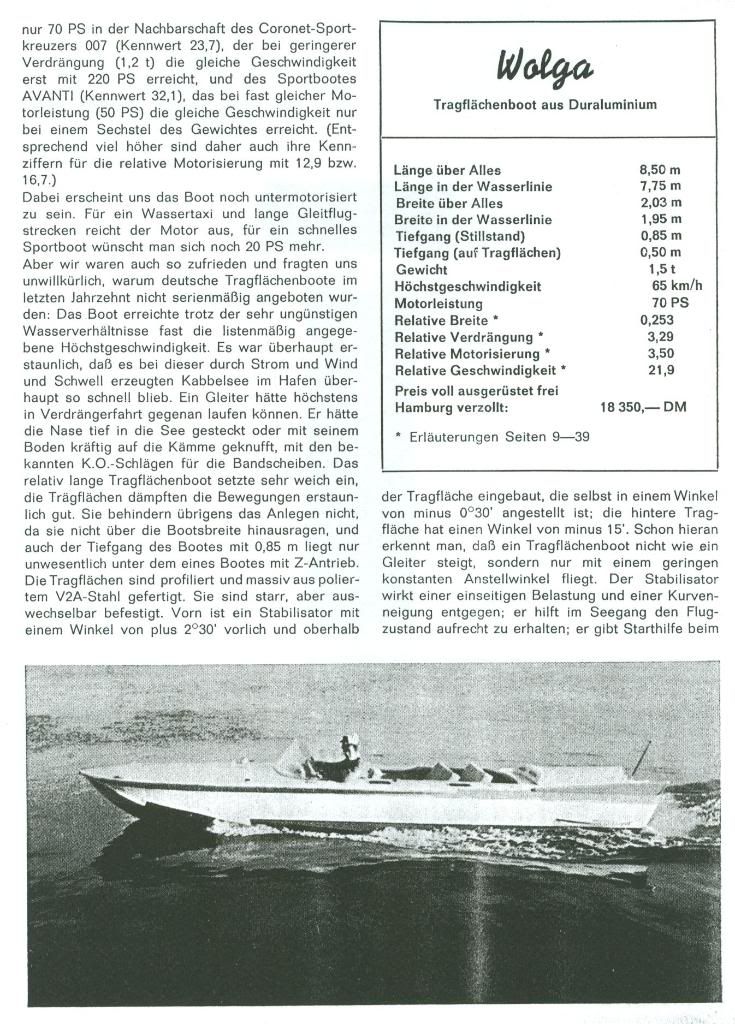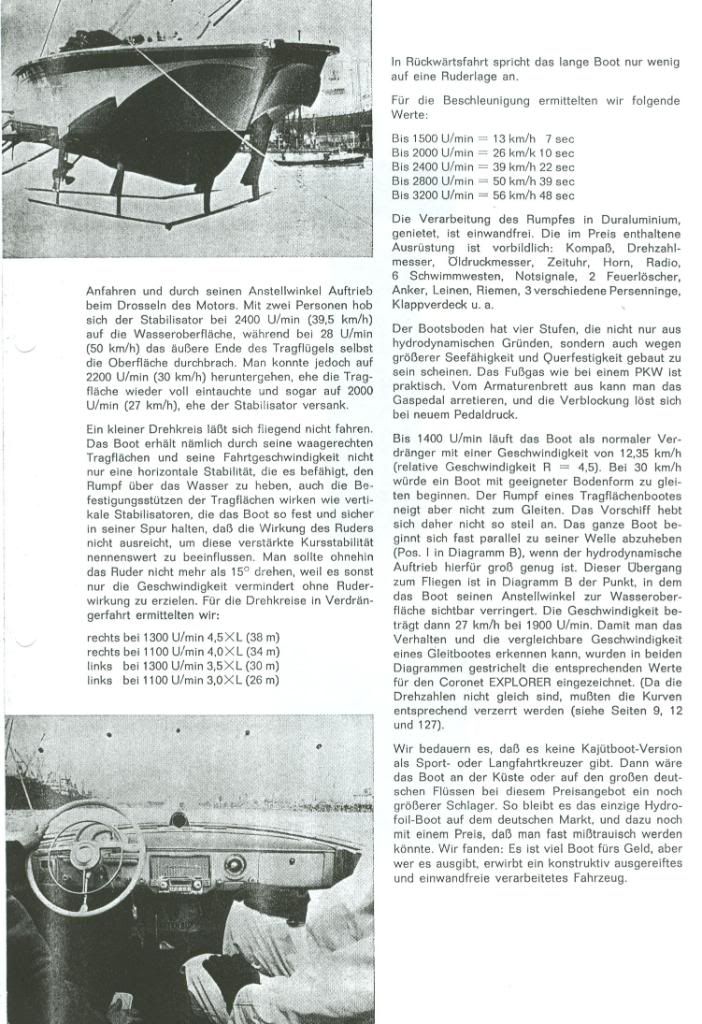Page 1 of 1
Volga test report (1965)
Posted: Wed Sep 09, 2009 1:28 pm
by olli
Re: Volga test report (1965)
Posted: Thu Sep 10, 2009 10:04 am
by Volga70
Hi Olli,
Thanks a lot for that great article! Do you remember where you found the article?
What is interesting is that it is a V-drive Volga with GAZ engine, not the export-model which usually had a Z-drive/Volvo engine. The importer that was mentioned was located in Hamburg, and the test-runs were on the Elbe, so this was a boat that was exported to 'the west'. On the other hand, the testrun mentioned in the article was in December 1965, so in the early days of the Volga. Perhaps the Volvo/X-drive version was just not being made yet.
Another thing: the author of the article mentions that he would prefer 20HP more power for this kind of boat. Our own Volga (the "officer's boat") is from 1965, looks exactly the same as the one in the article, and has a
plate in the engine compartment that was put there by the Howaldtswerke from Kiel, Germany, stating that the engine has 90 HP. Perhaps a previous owner of my Volga decided to have the engine tuned a bit to squeeze out more HP?
My German is a bit rusty, but I can still read it. Anyone out there who would care to translate this article for others to be able to read it?
Kind regards,
Maurits
Re: Volga test report (1965)
Posted: Mon Sep 14, 2009 12:03 am
by olli
Volga 70, glad you liked the report. Unfortunately I can't remember the name of the magazine. I found two of them in our library and copied only a few test reports. Shortly after that those magazines went to the junkyard

Re: Volga test report (1965)
Posted: Mon Sep 14, 2009 6:00 pm
by pitts12driver
For those who don't read German - here are the highlights of the article in English...
_____________________________________________________________________
- USSR only place that builds a sportsboat in hydrofoil format
- Technically, doesn’t glide, but really flies above the water, leading to a smooth ride even on rough seas
- This test of the boat was conducted on Dec 12, 1965 during rough weather and high winds
- 1500kg boat with only 70 horsepower – “relative motorization 3.5”
- Top speed 60km/h shows how small engine can achieve high speeds in hydrofoils compared to fast “gliders” that are placed deeper in the water: relative speed R = 20+ compared to fast non-hydrofoils 14 max (see left chart)
- Right chart shows angle vs. water surface at different rpm
- Wolga reaches 65km/h top speed with much lower relative motorization than various other sports boats that either are much lighter or have a much more powerful engine
- Overall, still appears undermotorized – sufficient for water taxi type use, but for real sports use another 20 hp required
- During the test, Wolga reached top speed as listed in spec in spite of very severe water and weather conditions
- The “wings” do not make berthing harder as they don’t extend beyond the width of the boat
- Boat has a draft of only .85m
- Wings are made from V2A steel; rigid but exchangeable
- At the front there’s a stabilizer attached above the wings at an angle of 2 degrees 30 minutes (the wings are positioned at an angle of -30 minutes; the back wings -15 minutes). From this it’s clear that the hydrofoil doesn’t climb like a glider, but flies at a small constant angle
- Stabilizer counteracts onesided load or pitch in curves; helps keep the boat flying when seas are rough; provides support during startup and lift when slowing down
- With two people the stabilizer was at water level at 2400 rpm (39.5km/h), while the wing broke through the surface at 2800 rpm (50km/h). However you could decelerate to 2200 rpm (30km/h) before the wings returned below the surface, and less than 2000 rpm (27km/h) before the stabilizer was submerged.
- Stabilizer stabilizes both horizontally and vertically, therefore can’t turn in a tight circle. Shouldn’t turn the rudder more than 15 degrees as above that it only slows the boat down without providing any turning effect
- Turning circles when not run in hydrofoil mode were observed as:
o Right 1300 rpm 38m
o Right 1100 rpm 34m
o Left 1300 rpm 30m
o Left 1100 rpm 26m
- When going backwards, the length of the boat results in minimal response to the rudder’s position.
- Acceleration was observed as follows:
o 1500 rpm = 13 km/h 7 sec
o 2000 rpm = 26 km/h 10 sec
o 2400 rpm = 39 km/h 22 sec
o 2800 rpm = 50 km/h 39 sec
o 3200 rpm = 56 km/h 48 sec
- Boat has four steps in its bottom that seem to have been added for better stability.
- Below 1400 rpm boat runs in non hydrofoil boat at 12.35km/h. A glider would start gliding at 30 km/h; but a hydrofoil is not made for gliding. Rather, it lifts itself parallel to the surface out of the water when there’s sufficient hydrodynamic lift. This transition to flight is indicated in diagram B where the angle vs. the water surface flattens out. At that point speed is 27 km/h at 1900 rpm. The dotted lines in both diagrams show the equivalent behavior for the Coronet EXPLORER glider – note that the curves are somewhat distorted as the rpms don’t align.
- It’s unfortunate the boat is not available with a cabin … but it’s still a lot of boat for little money.












